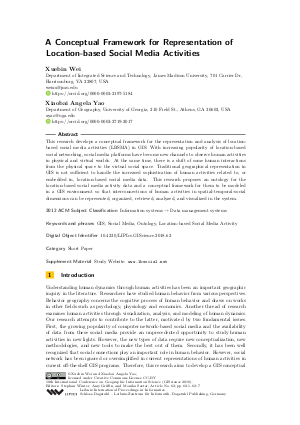A Conceptual Framework for Representation of Location-based Social Media Activities (Short Paper)
Authors
Xuebin Wei  ,
Xiaobai Angela Yao
,
Xiaobai Angela Yao 
-
Part of:
Volume:
10th International Conference on Geographic Information Science (GIScience 2018)
Part of: Series: Leibniz International Proceedings in Informatics (LIPIcs)
Part of: Conference: International Conference on Geographic Information Science (GIScience) - License:
 Creative Commons Attribution 3.0 Unported license
Creative Commons Attribution 3.0 Unported license
- Publication Date: 2018-08-02
File

PDF
LIPIcs.GISCIENCE.2018.62.pdf
- Filesize: 0.49 MB
- 7 pages
Document Identifiers
Subject Classification
ACM Subject Classification
- Information systems → Data management systems
Keywords
- GIS
- Social Media
- Ontology
- Location-based Social Media Activity
Metrics
- Access Statistics
-
Total Accesses (updated on a weekly basis)
0PDF Downloads0Metadata Views
Abstract
This research develops a conceptual framework for the representation and analysis of location-based social media activities (LBSMA) in GIS. With increasing popularity of location-based social networking, social media platforms have become new channels to observe human activities in physical and virtual worlds. At the same time, there is a shift of some human interactions from the physical space to the virtual social space. Traditional geographical representation in GIS is not sufficient to handle the increased sophistication of human activities related to, or embedded in, location-based social media data. This research proposes an ontology for the location-based social media activity data and a conceptual framework for them to be modeled in a GIS environment so that interconnections of human activities in spatial-temporal-social dimensions can be represented, organized, retrieved, analyzed, and visualized in the system.
Cite As Get BibTex
Xuebin Wei and Xiaobai Angela Yao. A Conceptual Framework for Representation of Location-based Social Media Activities (Short Paper). In 10th International Conference on Geographic Information Science (GIScience 2018). Leibniz International Proceedings in Informatics (LIPIcs), Volume 114, pp. 62:1-62:7, Schloss Dagstuhl – Leibniz-Zentrum für Informatik (2018)
https://doi.org/10.4230/LIPIcs.GISCIENCE.2018.62
BibTex
@InProceedings{wei_et_al:LIPIcs.GISCIENCE.2018.62,
author = {Wei, Xuebin and Yao, Xiaobai Angela},
title = {{A Conceptual Framework for Representation of Location-based Social Media Activities}},
booktitle = {10th International Conference on Geographic Information Science (GIScience 2018)},
pages = {62:1--62:7},
series = {Leibniz International Proceedings in Informatics (LIPIcs)},
ISBN = {978-3-95977-083-5},
ISSN = {1868-8969},
year = {2018},
volume = {114},
editor = {Winter, Stephan and Griffin, Amy and Sester, Monika},
publisher = {Schloss Dagstuhl -- Leibniz-Zentrum f{\"u}r Informatik},
address = {Dagstuhl, Germany},
URL = {https://drops.dagstuhl.de/entities/document/10.4230/LIPIcs.GISCIENCE.2018.62},
URN = {urn:nbn:de:0030-drops-93902},
doi = {10.4230/LIPIcs.GISCIENCE.2018.62},
annote = {Keywords: GIS, Social Media, Ontology, Location-based Social Media Activity}
}
Author Details
- Department of Integrated Science and Technology, James Madison University, 701 Carrier Dr, Harrisonburg, VA 22807, USA
Supplementary Materials
- Study Website: www.lbsocial.net
References
-
Torsten Hägerstrand. What About People in Regional Science? Papers in Regional Science, 24(1):7, 1970.

-
E. G. Knox and M. S. Bartlett. The Detection of Space-Time Interactions. Applied Statistics, 13(1):25, 1964.

-
Kevin Lewis, Jason Kaufman, Gonzalez A. Marco, Wimmer B. Andreas, and Christakis A. Nicholas. Tastes, ties, and time: A new social network dataset using Facebook.com. Social Networks, 30:330-342, 2008.

-
Yuan Li, Haoyu Gao, Mingmin Yang, Wanqiu Guan, Haixin Ma, Weining Qian, Zhigang Cao, and Xiaoguang Yang. What are Chinese Talking about in Hot Weibos? arXiv preprint arXiv:1304.4682, 2013.

-
Mor Naaman, Jeffrey Boase, and Chih-Hui Lai. Is it really about me?: message content in social awareness streams. In Proceedings of the 2010 ACM conference on Computer supported cooperative work, pages 189-192. ACM, 2010.

-
Sergio J. Rey and Luc Anselin. PySAL: A Python Library of Spatial Analytical Methods. The Review of Regional Studies, 37(1):5-27, 2007.

-
Tim Schwanen and Mei-Po Kwan. Critical Space-Time Geographies: Guest Editorial. Environment and Planning A, 44(9):2043-2048, 2012.

-
Daniel Sui and Michael Goodchild. The convergence of GIS and social media: challenges for GIScience. International Journal of Geographical Information Science, 25(11):1737, 2011.

-
Yuri Takhteyev, Anatoliy Gruzd, and Barry Wellman. Geography of Twitter networks. Social Networks, 34(1):73-81, 2012.

-
Ming-Hsiang Tsou and Michael Leitner. Visualization of social media: seeing a mirage or a message? Cartography and Geographic Information Science, 40(2):55, 2013.

-
Xiaobai Yao. Modeling and analyzing cities as spatio-temporal places. In Bin Jiang and Xiaobai Yao, editors, Geospatial Analysis and Modelling of Urban Structure and Dynamics, GeoJournal Library, pages 311-328. Springer, Dordrecht, the Netherlands, 2010.

-
May Yuan, Atsushi Nara, and James Bothwell. Space–time representation and analytics. Annals of GIS, 20(1):1-9, 2014.

